本科论文标准格式(英文)
- 格式:docx
- 大小:42.72 KB
- 文档页数:11
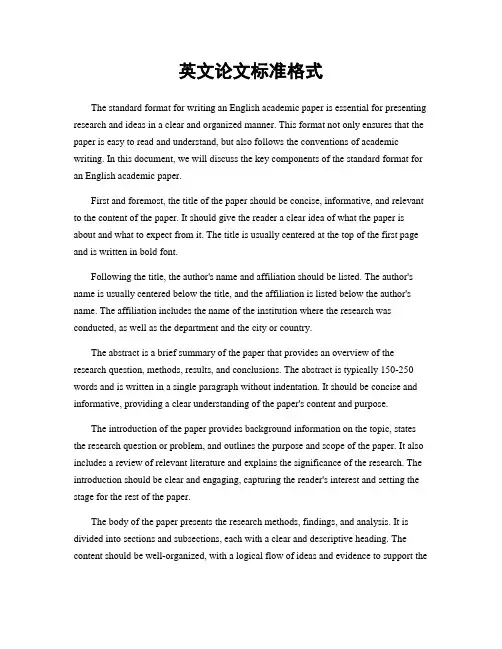
英文论文标准格式The standard format for writing an English academic paper is essential for presenting research and ideas in a clear and organized manner. This format not only ensures that the paper is easy to read and understand, but also follows the conventions of academic writing. In this document, we will discuss the key components of the standard format for an English academic paper.First and foremost, the title of the paper should be concise, informative, and relevant to the content of the paper. It should give the reader a clear idea of what the paper is about and what to expect from it. The title is usually centered at the top of the first page and is written in bold font.Following the title, the author's name and affiliation should be listed. The author's name is usually centered below the title, and the affiliation is listed below the author's name. The affiliation includes the name of the institution where the research was conducted, as well as the department and the city or country.The abstract is a brief summary of the paper that provides an overview of the research question, methods, results, and conclusions. The abstract is typically 150-250 words and is written in a single paragraph without indentation. It should be concise and informative, providing a clear understanding of the paper's content and purpose.The introduction of the paper provides background information on the topic, states the research question or problem, and outlines the purpose and scope of the paper. It also includes a review of relevant literature and explains the significance of the research. The introduction should be clear and engaging, capturing the reader's interest and setting the stage for the rest of the paper.The body of the paper presents the research methods, findings, and analysis. It is divided into sections and subsections, each with a clear and descriptive heading. The content should be well-organized, with a logical flow of ideas and evidence to support thearguments. The language should be precise and formal, using academic vocabulary and avoiding colloquial expressions.In the conclusion, the key findings and implications of the research are summarized, and suggestions for future research or applications are provided. The conclusion should be concise and focused, leaving a lasting impression on the reader and reinforcing the significance of the research.Finally, the references or bibliography lists all the sources cited in the paper. The references should be formatted according to a specific citation style, such as APA, MLA, or Chicago. Each entry should include the author's name, title of the work, publication information, and other relevant details.In conclusion, adhering to the standard format for writing an English academic paper is crucial for ensuring the clarity, organization, and professionalism of the research. By following these guidelines, authors can effectively communicate their research and ideas to a wider audience and contribute to the advancement of knowledge in their field.。
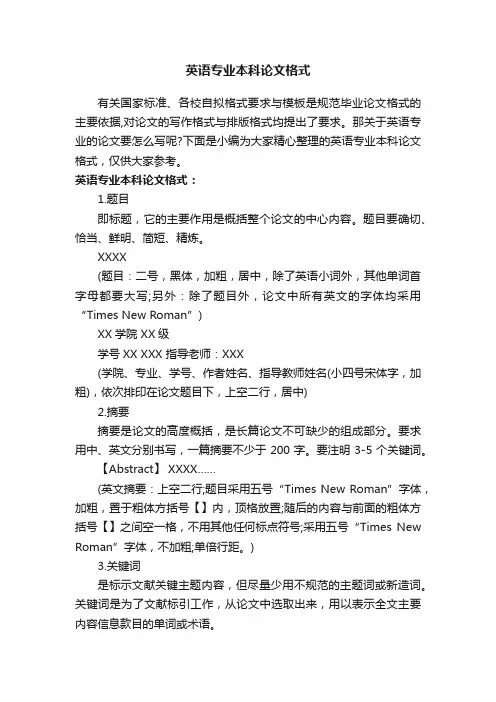
英语专业本科论文格式有关国家标准、各校自拟格式要求与模板是规范毕业论文格式的主要依据,对论文的写作格式与排版格式均提出了要求。
那关于英语专业的论文要怎么写呢?下面是小编为大家精心整理的英语专业本科论文格式,仅供大家参考。
英语专业本科论文格式:1.题目即标题,它的主要作用是概括整个论文的中心内容。
题目要确切、恰当、鲜明、简短、精炼。
XXXX(题目:二号,黑体,加粗,居中,除了英语小词外,其他单词首字母都要大写;另外:除了题目外,论文中所有英文的字体均采用“Times New Roman”)XX学院 XX级学号XX XXX 指导老师:XXX(学院、专业、学号、作者姓名、指导教师姓名(小四号宋体字,加粗),依次排印在论文题目下,上空二行,居中)2.摘要摘要是论文的高度概括,是长篇论文不可缺少的组成部分。
要求用中、英文分别书写,一篇摘要不少于200字。
要注明3-5个关键词。
【Abstract】XXXX……(英文摘要:上空二行;题目采用五号“Times New Roman”字体,加粗,置于粗体方括号【】内,顶格放置;随后的内容与前面的粗体方括号【】之间空一格,不用其他任何标点符号;采用五号“Times New Roman”字体,不加粗;单倍行距。
)3.关键词是标示文献关键主题内容,但尽量少用不规范的主题词或新造词。
关键词是为了文献标引工作,从论文中选取出来,用以表示全文主要内容信息款目的单词或术语。
【Key Words】 XX; XX;XX;XX(英文关键词:题目采用五号“Times New Roman”字体,加粗,两个单词的首字母要大写,置于粗体方括号【】内,顶格放置;随后的内容与前面的粗体方括号【】之间空一格,不用任何其他标点符号,采用五号“Times New Roman”字体,不加粗,除了专有名词外,其他单词的首字母不大写,各单词之间用分号“;”隔开,分号之后空一格;最后一个关键词之后不用任何标点符号;单倍行距。
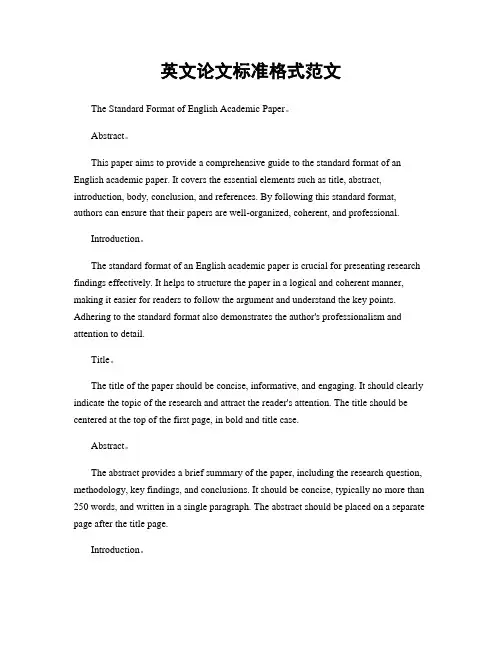
英文论文标准格式范文The Standard Format of English Academic Paper。
Abstract。
This paper aims to provide a comprehensive guide to the standard format of an English academic paper. It covers the essential elements such as title, abstract, introduction, body, conclusion, and references. By following this standard format, authors can ensure that their papers are well-organized, coherent, and professional.Introduction。
The standard format of an English academic paper is crucial for presenting research findings effectively. It helps to structure the paper in a logical and coherent manner, making it easier for readers to follow the argument and understand the key points. Adhering to the standard format also demonstrates the author's professionalism and attention to detail.Title。
The title of the paper should be concise, informative, and engaging. It should clearly indicate the topic of the research and attract the reader's attention. The title should be centered at the top of the first page, in bold and title case.Abstract。
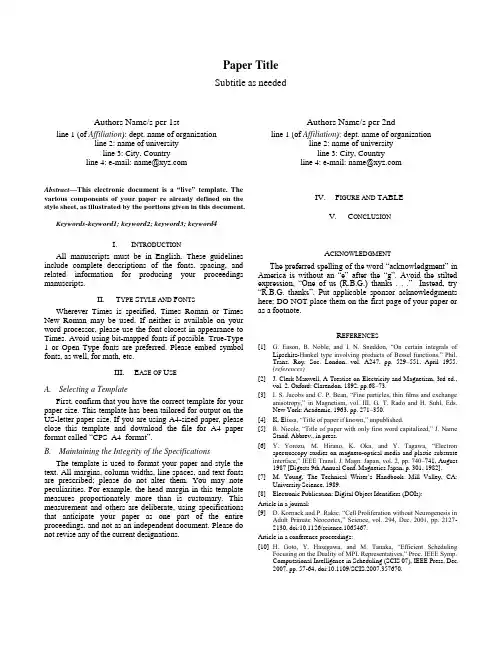
Paper Title Subtitle as neededAuthors Name/s per 1stline 1 (of Affiliation): dept. name of organization line 2: name of universityline 3: City, Countryline4:e-mail:************Authors Name/s per 2ndline 1 (of Affiliation): dept. name of organization line 2: name of universityline 3: City, Countryline4:e-mail:************Abstract—This electronic document is a “live” template. The various components of your paper re already defined on the style sheet, as illustrated by the portions given in this document.Keywords-keyword1; keyword2; keyword3; keyword4I.I NTRODUCTIONAll manuscripts must be in English. These guidelines include complete descriptions of the fonts, spacing, and related information for producing your proceedings manuscripts.II.T YPE S TYLE AND F ONTSWherever Times is specified, Times Roman or Times New Roman may be used. If neither is available on your word processor, please use the font closest in appearance to Times. Avoid using bit-mapped fonts if possible. True-Type 1 or Open Type fonts are preferred. Please embed symbol fonts, as well, for math, etc.III.E ASE OF U SEA.Selecting a TemplateFirst, confirm that you have the correct template for your paper size. This template has been tailored for output on the US-letter paper size. If you are using A4-sized paper, please close this template and download the file for A4 paper format called “CPS_A4_format”.B.Maintaining the Integrity of the SpecificationsThe template is used to format your paper and style the text. All margins, column widths, line spaces, and text fonts are prescribed; please do not alter them. You may note peculiarities. For example, the head margin in this template measures proportionately more than is customary. This measurement and others are deliberate, using specifications that anticipate your paper as one part of the entire proceedings, and not as an independent document. Please do not revise any of the current designations.IV.F IGURE AND TABLEV.C ONCLUSIONA CKNOWLEDGMENTThe preferred spelling of the word “acknowledgment” in America is without an “e” after the “g”. Avoid the stilted expression, “One of us (R.B.G.) thanks . . .” Instead, try “R.B.G. thanks”. Put applicable sponsor acknowledgments here; DO NOT place them on the first page of your paper or as a footnote.R EFERENCES[1]G. Eason, B. Noble, and I. N. Sneddon, “On certain integrals ofLipschitz-Hankel type involving products of Bessel functions,” Phil.Trans. Roy. Soc. London, vol. A247, pp. 529–551, April 1955.(references)[2]J. Clerk Maxwell, A Treatise on Electricity and Magnetism, 3rd ed.,vol. 2. Oxford: Clarendon, 1892, pp.68–73.[3]I. S. Jacobs and C. P. Bean, “Fine particles, thin films and exchangeanisotropy,” in Magnetism, vol. III, G. T. Rado and H. Suhl, Eds.New York: Academic, 1963, pp. 271–350.[4]K. E lissa, “Title of paper if known,” unpublished.[5]R. Nicole, “Title of paper with only first word capitalized,” J. NameStand. Abbrev., in press.[6]Y. Yorozu, M. Hirano, K. Oka, and Y. Tagawa, “Electronspectroscopy studies on magneto-optical media and plastic substrate interface,” IEEE Transl. J. Magn. Japan, vol. 2, pp. 740–741, August 1987 [Digests 9th Annual Conf. Magnetics Japan, p. 301, 1982]. [7]M. Young, The Technical Writer’s Handbook. Mill Valley, CA:University Science, 1989.[8]Electronic Publication: Digital Object Identifiers (DOIs):Article in a journal:[9] D. Kornack and P. Rakic, “Cell Proliferation without Neurogenesis inAdult Primate Neocortex,” Science, vol. 294, Dec. 2001, pp. 2127-2130, doi:10.1126/science.1065467.Article in a conference proceedings:[10]H. Goto, Y. Hasegawa, and M. Tanaka, “Efficient SchedulingFocusing on the Duality of MPL Representatives,” Proc. IEEE Symp.Computational Intelligence in Scheduling (SCIS 07), IEEE Press, Dec.2007, pp. 57-64, doi:10.1109/SCIS.2007.357670.We suggest that you use a text box to insert a graphic (ideally 300 dpi), with all fonts embedded) because, in an MSW document, this method is somewhat more stable than directly inserting a picture.To have non-visible rules on your frame, use the MSWord pull-down menu, select Format > Borders and Shading > Select “None”.TABLE I.T ABLE T YPE S TYLES Table Head Table Column HeadTable column subhead Subhead SubheadcopyMore table copy aFigure 1. Example of a ONE-COLUMN figure caption.Figure 2. Example of a TWO-COLUMN figure caption: (a) this is the format for referencing parts of a figure.。
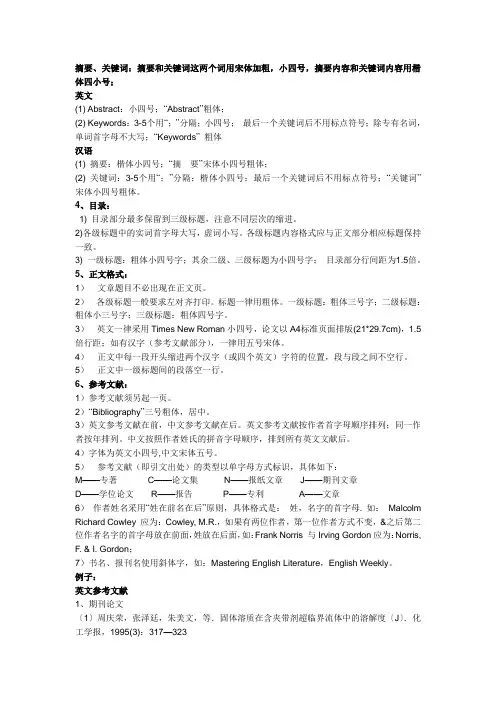
摘要、关键词:摘要和关键词这两个词用宋体加粗,小四号,摘要内容和关键词内容用楷体四小号;英文(1) Abstract:小四号;“Abstract”粗体;(2) Keywords:3-5个用“;”分隔;小四号;最后一个关键词后不用标点符号;除专有名词,单词首字母不大写;“Keywords”粗体汉语(1) 摘要:楷体小四号;“摘要”宋体小四号粗体;(2) 关键词:3-5个用“;”分隔;楷体小四号;最后一个关键词后不用标点符号;“关键词”宋体小四号粗体。
4、目录:1) 目录部分最多保留到三级标题,注意不同层次的缩进。
2)各级标题中的实词首字母大写,虚词小写。
各级标题内容格式应与正文部分相应标题保持一致。
3) 一级标题:粗体小四号字;其余二级、三级标题为小四号字;目录部分行间距为1.5倍。
5、正文格式:1)文章题目不必出现在正文页。
2)各级标题一般要求左对齐打印。
标题一律用粗体。
一级标题:粗体三号字;二级标题:粗体小三号字;三级标题:粗体四号字。
3)英文一律采用Times New Roman小四号,论文以A4标准页面排版(21*29.7cm),1.5倍行距;如有汉字(参考文献部分),一律用五号宋体。
4)正文中每一段开头缩进两个汉字(或四个英文)字符的位置,段与段之间不空行。
5)正文中一级标题间的段落空一行。
6、参考文献:1)参考文献须另起一页。
2)“Bibliography”三号粗体,居中。
3)英文参考文献在前,中文参考文献在后。
英文参考文献按作者首字母顺序排列;同一作者按年排列。
中文按照作者姓氏的拼音字母顺序,排到所有英文文献后。
4)字体为英文小四号,中文宋体五号。
5)参考文献(即引文出处)的类型以单字母方式标识,具体如下:M——专著C——论文集N——报纸文章J——期刊文章D——学位论文R——报告P——专利A——文章6)作者姓名采用“姓在前名在后”原则,具体格式是:姓,名字的首字母. 如:Malcolm Richard Cowley 应为:Cowley, M.R.,如果有两位作者,第一位作者方式不变,&之后第二位作者名字的首字母放在前面,姓放在后面,如:Frank Norris 与Irving Gordon应为:Norris, F. & I. Gordon;7)书名、报刊名使用斜体字,如:Mastering English Literature,English Weekly。
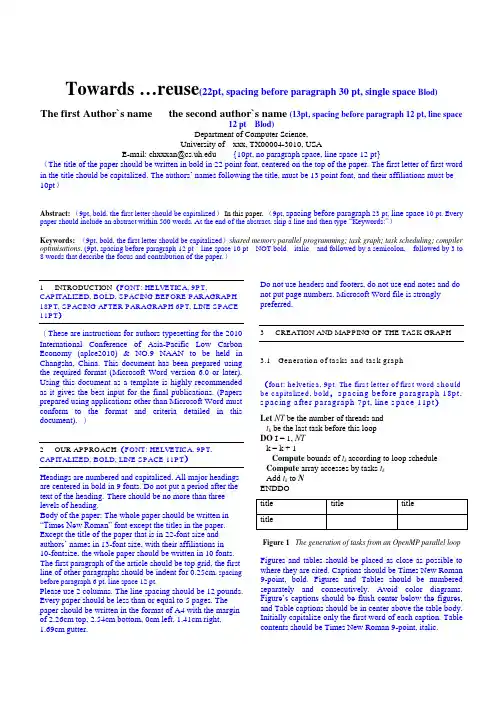
Towards …reuse(22pt, spacing before paragraph 30 pt, single space Blod)The first Author`s name the second author`s name(13pt, spacing before paragraph 12 pt, line space12 pt Blod)Department of Computer Science,University of xxx, TX00004-3010, USAE-mail: chxxxan@{10pt, no paragraph space, line space 12 pt}(The title of the paper should be written in bold in 22 point font, centered on the top of the paper. The first letter of first word in the title should be capitalized. The authors‟ names following the title, must be 13 point font, and their affiliations must be 10pt)Abstract:(9pt, bold, the first letter should be capitalized)In this paper, (9pt, spacing before paragraph 23 pt, line space 10 pt. Every paper should include an abstract within 500 words. At the end of the abstract, skip a line and then type “Keywords:”)Keywords:(9pt, bold, the first letter should be capitalized)shared memory parallel programming; task graph; task scheduling; compiler optimisations. (9pt, spacing before paragraph 12 pt line space 10 pt NOT bold italic and followed by a semicolon, followed by 3 to 8 words that describe the focus and contribution of the paper.)1 INTRODUCTION(FONT: HELVETICA, 9PT, CAPITALIZED, BOLD, SPACING BEFORE PARAGRAPH 18PT, SPACING AFTER PARAGRAPH 6PT, LINE SPACE 11PT)(These are instructions for authors typesetting for the 2010 International Conference of Asia-Pacific Low Carbon Economy (aplce2010) & NO.9 NAAN to be held in Changsha, China. This document has been prepared using the required format (Microsoft Word version 6.0 or later). Using this document as a template is highly recommended as it gives the best input for the final publications. (Papers prepared using applications other than Microsoft Word must conform to the format and criteria detailed in this document). )2 OUR APPROACH(FONT: HELVETICA, 9PT, CAPITALIZED, BOLD, LINE SPACE 11PT)Headings are numbered and capitalized. All major headings are centered in bold in 9 fonts. Do not put a period after the text of the heading.There should be no more than three levels of heading.Body of the paper: The whole paper should be written in “Times New Roman” font except the titles in the paper. Except the title of the paper that is in 22-font size and authors‟ names in 13-font size, with their affiliations in10-fontsize, the whole paper should be written in 10 fonts. The first paragraph of the article should be top grid, the first line of other paragraphs should be indent for 0.25cm, spacing before paragraph 6 pt, line space 12 pt.Please use 2 columns. The line spacing should be 12 pounds. Every paper should be less than or equal to 5 pages. The paper should be written in the format of A4 with the margin of 2.26cm top, 2.54cm bottom, 0cm left, 1.41cm right,1.69cm gutter. Do not use headers and footers, do not use end notes and do not put page numbers. Microsoft Word file is strongly preferred.3 CREATION AND MAPPING OF THE TASK GRAPH 3.1 Generation of tasks and task graph(font: helvetica, 9pt. The first letter of first word should be capitalized, bold,spacing before paragraph 18pt, spacing after paragraph 7pt, line space 11pt)Let NT be the number of threads andt k be the last task before this loopDO I = 1, NTk = k + 1Compute bounds of t k according to loop schedule Compute array accesses by tasks t kAdd t k to NENDDOFigure 1 The generation of tasks from an OpenMP parallel loop Figures and tables should be placed as close as possible to where they are cited. Captions should be Times New Roman 9-point, bold. Figures and Tables should be numbered separately and consecutively. Avoid color diagrams. Figure‟s captions should be flush center below the figures, and Table captions should be in center above the table body. Initially capitalize only the first word of each caption. Table contents should be Times New Roman 9-point, italic.All equations should be placed on separate lines and numbered consecutively, with the equation numbers placed within parentheses and aligned against the right margin.Figure 18 ADI kernel code ACKNOWLEDGEMENT(FONT: HELVETICA, 9PT, CAPITALIZED, BOLD)Use the singular heading even if you have many acknowledgments.Sponsor and financial support acknowledgments expre ssions such as “This research was supported by the National Natural Science Foundation of China under Grant 123456”.REFERENCES(FONT: HELVETICA, 9PT, CAPITALIZED, BOLD)Balasundaram, V. and Kennedy, K. (1989) …A techniques for summarising data access and its use in parallelism enhancing transformations‟, Proceedings of ACM SIGPLAN’89 Conference on Programming Language Design and Implementation, June.Hanging indent 0.51cm, line space 10 pt。

英文论文的详细格式(英文论文写作格式)英文论文的写作主要用于参加国际学术研讨会,以促进中外学术和文化交流;在国际学术期刊上发表论文,在国际上分享科研成果,并在英语论文中进行学术交流;此外,英文论文还包括英语相关专业人士必须用英语撰写学术报告或毕业论文等。
标题大纲摘要1、英文摘要是一篇文章,旨在以符合英语语法的语言提供论文内容的摘要。
(内容与中文摘要基本相同,但不需要完全判断。
)2、英文标题、摘要、关键字进入一个页面(可以是1页),放在中文摘要页面之后。
3、英文字体和行间距:在“Western字体”中使用“Times New Roman”,1.5行间距。
4、英文名称:使用第三个单词bold。
5、英文摘要:“Absract”顶部网格,使用第四个字母和粗体。
英文摘要使用第四个字母。
6、英文关键词:“关键词”顶部网格,使用第四个单词和粗体。
对每个关键字使用第四个单词文本在文中引用如果引用少于三行,则引文可以有机地整合到纸张中。
如果要引用的单词具有与需要删除的纸张无关的单词,则需要省略号。
如果省略号出现在引文中,请使用三个点。
如果它出现在引文的末尾,请使用四个点。
最后一个点表示句点并放在第二个括号之后(通常,避免在引用开始时使用省略号);点和字母之间或点和点之间的空格。
参考书目每个项目的第一行需要打印在顶部网格中,并且所有行都需要缩进五次以区分该项目与其他项目。
英文摘要英文论文摘要,也称为摘要,是论文的重要组成部分。
它旨在提供文献内容的摘要,没有评论和补充说明。
一篇简短的文章,准确描述了文献的重要内容。
摘要应该是独立和不言而喻的,并且与文献具有相同数量的信息,即,可以在不阅读全文的情况下获得重要信息。
摘要通常放在标题之后,即文章的第一篇。
在论文发表后,论文的摘要经常被文献检索系统收集。
英文摘要一般为200-300个单词,并且有一个与英文抽象表达相对应的中文摘要。
,。
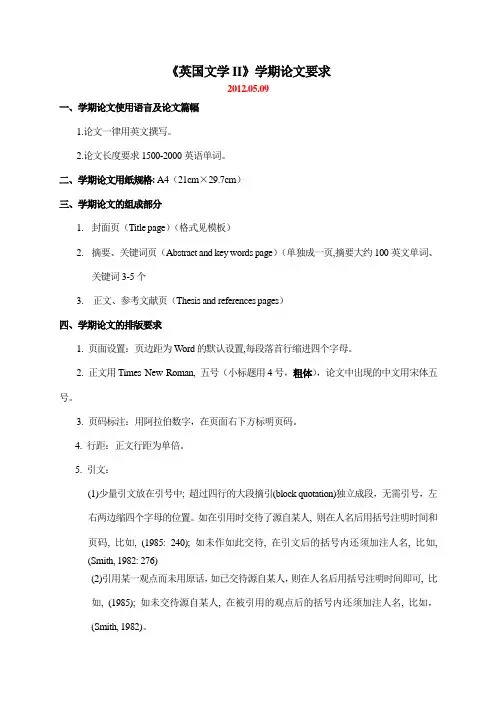
《英国文学II》学期论文要求2012.05.09一、学期论文使用语言及论文篇幅1.论文一律用英文撰写。
2.论文长度要求1500-2000英语单词。
二、学期论文用纸规格: A4(21cm×29.7cm)三、学期论文的组成部分1.封面页(Title page)(格式见模板)2.摘要、关键词页(Abstract and key words page)(单独成一页,摘要大约100英文单词、关键词3-5个3. 正文、参考文献页(Thesis and references pages)四、学期论文的排版要求1. 页面设置:页边距为Word的默认设置,每段落首行缩进四个字母。
2. 正文用Times New Roman, 五号(小标题用4号,粗体),论文中出现的中文用宋体五号。
3. 页码标注:用阿拉伯数字,在页面右下方标明页码。
4. 行距:正文行距为单倍。
5. 引文:(1)少量引文放在引号中; 超过四行的大段摘引(block quotation)独立成段,无需引号,左右两边缩四个字母的位置。
如在引用时交待了源自某人, 则在人名后用括号注明时间和页码, 比如, (1985: 240); 如未作如此交待, 在引文后的括号内还须加注人名, 比如, (Smith, 1982: 276)(2)引用某一观点而未用原话,如已交待源自某人,则在人名后用括号注明时间即可, 比如, (1985); 如未交待源自某人, 在被引用的观点后的括号内还须加注人名, 比如,(Smith, 1982)。
(3)人名和时间等须和参考文献中的一致。
6. 标题对齐方式:论文中的各级标题一律左对齐。
一级标题用“1.…”的格式标注,二级标题用“1.1 …”,三级“1.1.1 …”,比如:1.…1.1 …1.1.1 …1.1.2 …1.2 …1.2.1 …1.2.2 …2.…2.1 …2.1.1 ……依此类推。
五、学期论文参考文献要求1.参考文献的数量要求:不少于5种(其中英文文献不少于2种),先列英文参考文献,后列中文参考文献。
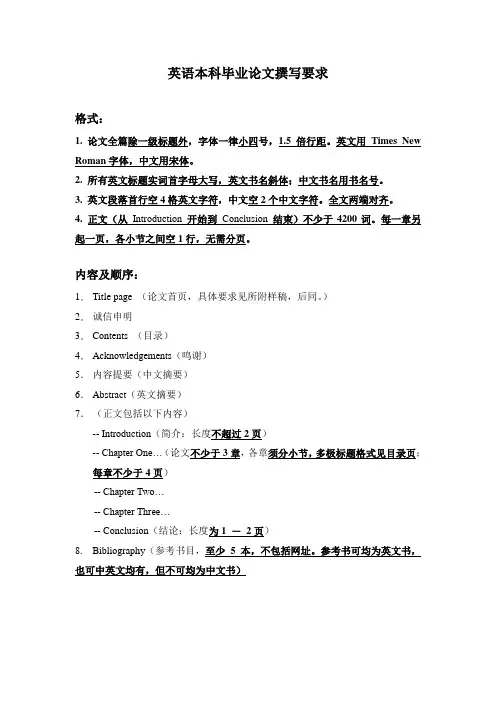
英语本科毕业论文撰写要求格式:1. 论文全篇除一级标题外,字体一律小四号,1.5倍行距。
英文用Times New Roman字体,中文用宋体。
2. 所有英文标题实词首字母大写,英文书名斜体;中文书名用书名号。
3. 英文段落首行空4格英文字符,中文空2个中文字符。
全文两端对齐。
4. 正文(从Introduction开始到Conclusion结束)不少于4200词。
每一章另起一页,各小节之间空1行,无需分页。
内容及顺序:1.Title page (论文首页,具体要求见所附样稿,后同。
)2.诚信申明3.Contents (目录)4.Acknowledgements(鸣谢)5.内容提要(中文摘要)6.Abstract(英文摘要)7.(正文包括以下内容)-- Introduction(简介:长度不超过2页)-- Chapter One…(论文不少于3章,各章须分小节,多极标题格式见目录页;每章不少于4页)-- Chapter Two…-- Chapter Three…-- Conclusion(结论:长度为1 -2页)8. Bibliography(参考书目,至少5本,不包括网址。
参考书可均为英文书,也可中英文均有,但不可均为中文书)样稿(论文首页)Dream Shattered-- A Tentative Analysis of Martin Eden(论文题目,小二号字,该页其余部分四号字。
加粗,居中,实词首字母大写)A Paper Presented toCollege of Continuing EducationShanghai International Studies UniversityIn Partial Fulfillment of the RequirementsFor the Degree of Bachelor of ArtsBy WANG Meiyuan(自己姓名,姓大写,名首字母大写)Under the Supervision ofMr.(或)Ms. Xxx(导师姓名,姓大写,名首字母大写)(空1行)December, 2011(论文定稿完成年月)Contents(所有大标题居中,小三号字,加粗,与下文之间空1行)(论文大小标题以名词或分词短语构成,须提纲挈领。
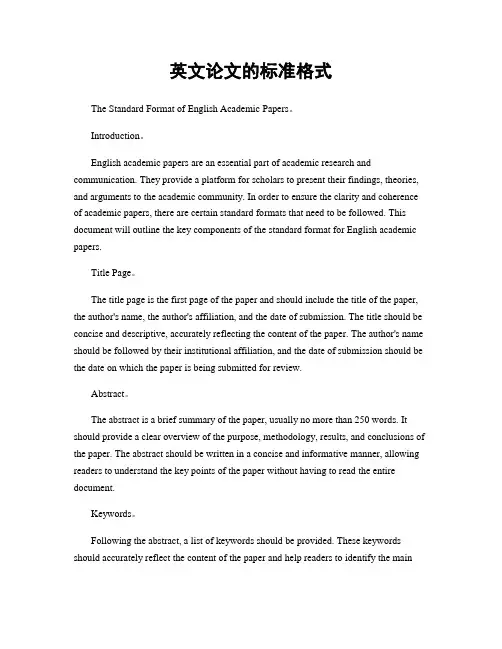
英文论文的标准格式The Standard Format of English Academic Papers。
Introduction。
English academic papers are an essential part of academic research and communication. They provide a platform for scholars to present their findings, theories, and arguments to the academic community. In order to ensure the clarity and coherence of academic papers, there are certain standard formats that need to be followed. This document will outline the key components of the standard format for English academic papers.Title Page。
The title page is the first page of the paper and should include the title of the paper, the author's name, the author's affiliation, and the date of submission. The title should be concise and descriptive, accurately reflecting the content of the paper. The author's name should be followed by their institutional affiliation, and the date of submission should be the date on which the paper is being submitted for review.Abstract。
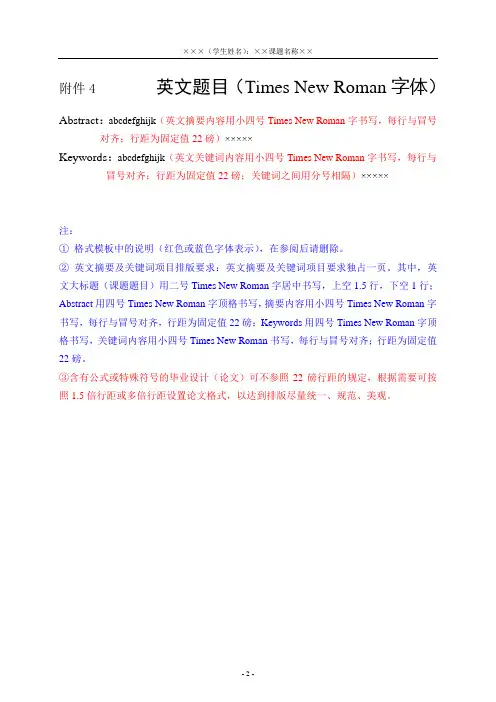
×××(学生姓名):××课题名称××
附件4 英文题目(Times New Roman字体)
Abstract:abcdefghijk(英文摘要内容用小四号Times New Roman字书写,每行与冒号对齐;行距为固定值22磅)×××××
Keywords:abcdefghijk(英文关键词内容用小四号Times New Roman字书写,每行与冒号对齐;行距为固定值22磅;关键词之间用分号相隔)×××××
注:
①格式模板中的说明(红色或蓝色字体表示),在参阅后请删除。
②英文摘要及关键词项目排版要求:英文摘要及关键词项目要求独占一页。
其中,英文大标题(课题题目)用二号Times New Roman字居中书写,上空1.5行,下空1行;Abstract用四号Times New Roman字顶格书写,摘要内容用小四号Times New Roman字书写,每行与冒号对齐,行距为固定值22磅;Keywords用四号Times New Roman字顶格书写,关键词内容用小四号Times New Roman书写,每行与冒号对齐;行距为固定值22磅。
③含有公式或特殊符号的毕业设计(论文)可不参照22磅行距的规定,根据需要可按照1.5倍行距或多倍行距设置论文格式,以达到排版尽量统一、规范、美观。
- 2 -。
1 总要求(General Requirements)1、用英文撰写、字数要求学士论文长度为 4000 字,以能清楚、充分地论证某一论题或描写、解释某一发现为最低限度。
以上字数的统计范围仅限于论文正文,不包括论文摘要、目录、注释、参考书目和致谢。
2、格式要求论文一般由以下部分组成,并按此顺序排列:1. 英文标题页(English title page)2. 学位论文原创性声明(答辩时另发)3. 英文提要(Abstract)4. 中文提要(Chinese abstract)5. 目录(Contents)6. 正文(Text)7. 注释(Notes 非必须)8.参引文献(References,见附录)9. 致谢(Acknowledgements)(2)字体和字号:正文中大标题采用Times New Roman 小四号加粗(Introduction和Conclusion两词四号加粗,次标题以下采用 Times New Roman 小四号加粗,正文采用 Times New Roman 小四号字。
注意:大标题和次标题不得采用句子。
(3)行距:一律 1.5 行距。
(4)页边距:2cm。
3、注释要求(一律采用“尾注Notes”,用序号,按出现顺序排列:名字在前,姓氏在后,其他与参考文献同。
)4、从论文的正文至致谢,均要求采用“页眉”(页眉右对齐)和“页码”(页码应居中)。
并在目录中标出。
封面(空两行;页边距为2cm)(Please write the English title of your thesis here)(Arial 一号加粗居中)(Please write the Chinese title of your thesis here)(宋体一号加粗居中)(空两行)Submitted by (Please write your name here) (Arial 三号加粗居中)Student number ( Please write your ID here ) (Arial 三号加粗居中)Supervised by (Please write the name of your tutor here) (Arial 三号加粗居中)(空两行)Foreign Languages College(Arial 小三号加粗居中)Jiangxi Normal University(Arial 小三号加粗居中)(Insert Month here) (Insert Year here) (Arial 小三号加粗居中)Title of the thesis(Times New Roman 三号粗体居中)(空一行)Abstract(Times New Roman 小四号加粗):正文(Times New Roman 小四号)………………………………………………………………………………………………………(空一行)Key words(Times New Roman 小四号加粗):正文(Times New Roman 小四号)…………………………………………………………………………………………摘要之后另起一行,给出论文的关键词3-5个(关键词要用分号“;” 分隔,结束不用句号,关键词不能超过5个)中文题目(宋体三号粗体居中)(空一行)摘要(宋体小四号加粗):正文(宋体小四号)………………………………………………………………………………………………………………………………………(空一行)关键词(宋体小四号加粗):正文(宋体小四号)………………………………………………………………………………………………(用分号“;”分隔,结束不用句号,)(空一行)提要格式要求:1、中文、英文摘要分页打印2、A4纸打印3、页边距:2cm4、行距:1.5倍行距Contents (Times New Roman 三号粗体居中)(空两行)Abstract (i)摘要 (ii)Introduction (1)1. ……………………………………………………………………………………1.1 ……………………………………………………………………………………1.2 …………………………………………………………………………………..2. ……………………………………………………………………………………..2.1 …………………………………………………………………………………..2.2 …………………………………………………………………………………..2.3 ……………………………………………………………………………………3. …………………………………………………………………………………….…Notes………………………………………………………………………………………….. Bibliography…………………………………………………………………………………. Acknowledgements……………………………………………………………………………目录格式要求:目录要自动生成!!所有标题都设为一级标题并顶格排列1、字体要求:Times New Roman 小四号粗体2、A4纸打印3、页边距:2cm4、行距:1.5倍行距5、论文内容排序:封面—声明—Abstract—摘要—Contents—正文—尾注—参考文献—致谢(空一行)Introduction (Times New Roman 四号加粗居中)(空一行)(5spaces) 正文……………………………………………………………………………………………………………………………………………………………………………(空一行)1 (Times New Roman小四号加粗)(5spaces) 正文……………………………………………………………………………………………………………………………………………………………………………1.1(Times New Roman小四号加粗)(5spaces) 正文……………………………………………………………………………………………………………………………………………………………………………1.1.1(Times New Roman小四号加粗)(5spaces) 正文………………………………………………………………………………………………………………………………………………………………………1.1.2(Times New Roman小四号加粗)(5spaces) 正文…………………………………………………………………………………………………………………………………………………………………………1.2(Times New Roman小四号加粗)(5spaces) 正文………………………………………………………………………………………………………………………………………………………………………1.2.1(Times New Roman小四号加粗)(5spaces) 正文………………………………………………………………………………………………………………………………………………………………………1.2.2(Times New Roman小四号加粗)(5spaces) 正文……………………………………………………………………………………………………………………………………………………………………2 (Times New Roman小四号加粗)(5spaces) 正文……………………………………………………………………………………………………………………………………………………………………………2.1(Times New Roman小四号加粗)(5spaces) 正文……………………………………………………………………………………………………………………………………………………………………………2.1.1(Times New Roman小四号加粗)(5spaces) 正文………………………………………………………………………………………………………………………………………………………………………2.1.2(Times New Roman小四号加粗)(5spaces) 正文…………………………………………………………………………………………………………………………………………………………………………2.2(Times New Roman小四号加粗)(5spaces) 正文………………………………………………………………………………………………………………………………………………………………………2.2.1(Times New Roman小四号加粗)(5spaces) 正文………………………………………………………………………………………………………………………………………………………………………2.2.2(Times New Roman小四号加粗)(5spaces) 正文……………………………………………………………………………………………………………………………………………………………………3 (Times New Roman小四号加粗)4 (Times New Roman小四号加粗)…Conclusion(Times New Roman 四号加粗居中)(5spaces) 正文………………………………………………………………………………………………………………………………………………………………………(另起一页)Notes(Times New Roman 四号加粗居中)正文(Times New Roman 小四号)[1]作者,书名(英文书名格式为Times New Roman小四号斜体;中文书名格式为《宋体小四号》),出版社,出版时间:页码.(有一实心点作为句号)[2]如出处同上一个注释,则标为ibid(空一格)(页码).[3]……(另起一页)Bibliography(Times New Roman 四号加粗居中)英文参考书目(按首写字母顺序排列)网络参考资料中文参考书目(按汉语拼音顺序排列)参考文献写作规范1.说明(1)文献目录应另页书写,外文文献排前,中文文献排后。
英语毕业论文写作及排版格式第一部分:封面1、需填写的项目由本人用碳素墨水手写或打印。
2、封面上的毕业论文(设计)编号填写统一编排的12位学号。
3、届、班级均采用阿拉伯数字,班级应标明某级某班。
4、用纸要求(以下所有用纸按此要求)·纸型:A4纸,单面打印;·页边距:上2.54cm,下2.5cm,左2.5cm,右2.5cm;·页眉:4.5cm,页脚:1.8cm,左侧装订。
第二部分:目录(单独用一页对齐方式:两端对齐、1.5倍行距)目录(标题三号,TimesNewRoman,加粗,居中;)摘要(关键词)(小四号,TimesNewRoman)……………………………………(页码)英文摘要(关键词)(小四号,TimesNewRoman)………………………………………(页码)致谢(小四号,TimesNewRoman)……………………………………………………………(页码)1.Introduction………(小四号,TimesNewRoman)………………………………………………(页码)2.XXXXXX(一级标题)(小四号,TimesNewRoman)…………………………………(页码)2.1XXXXXX(二级标题)(小四号,TimesNewRoman)…………………………………(页码)2.1.1XXXXX(三级标题)(小四号,TimesNewRoman)……………………………………(页码)(注:此处目录中的标题层次根据正文标题层次来确定)参考文献(小四号,TimesNewRoman)………………………………………………………(页码) 第三部分:文章标题、摘要与关键词1.文章标题:二号、TimesNewRoman、加粗、居中题目:应在20个单词以内,能简明、具体、确切地表达论文的特定内容。
必要时可使用副标题;2.中文摘要、关键词(中英文关键词、摘要段落:左右缩进2个字符)摘要:(小三号,黑体,加粗,居中)摘要正文(小四号,宋体,双倍行距)关键词:标题(小四号,黑体,顶格,加粗)关键词正文(小四号,宋体,词间逗号隔开)3.英文摘要、英文关键词英文摘要标题Abstract:(小三号,TimesNewRoman,加粗,居中)英文摘要正文(小四号,TimesNewRoman,双倍行距)英文关键词标题Keywords:(小四号,TimesNewRoman,加粗,顶格)英文关键词正文(小四号,TimesNewRoman,词间用逗号隔开)第四部分:主体部分正文:论文正文都必须包括引言(introduction),正体、结束语(conclusion)论点正确、逻辑性强、文理通顺、层次分明、表达确切。
英文论文报告参考文献格式用Times New Roman.每一条目顶格,如某一条目超过一行,从第二行起“悬挂缩进”2字符。
参考文献中所有标点与符号均在英文状态下输入,标点符号后空一格。
参考条目顺序:英国文学、中国文学、网络文学。
他们是按姓氏的字母顺序排列的。
文件前不使用序列号。
1)英文参考文献:(1)专著与编著排列顺序为:姓、名、专有名称、出版地、出版社、出版年份。
例如:Brinkleyork: Knopf, 1993.如果名著中有其他作品或书名,则后者为斜体。
例如:Dunn, Richard J ed. Charlotte Bront: Jane EyreNew York: Norton, 1971.A、两个至三个第一的姓在前,名在后,中间用逗号隔开;其余名在前,姓在后,中间无逗号;每个之间用逗号隔开,最后一个的姓名前用“and”,后用句号。
例如:B、三个以上第一姓名(姓在前,名在后,中间加逗号)后接“et al.”,其他姓名省略。
例如:University of Hawaii Press, 1997.C、同一同一年出版的不同文献,参照下例:Widdowson, Henry G1998a.Widdowson, Henry G. Cambridge:Cambridge University Press, 1998b.(2)论文集参照下例:Thompson, Pett. “Modal Verbs in Academic Writing”. In Ben Kettlemann & York: Rodopi, 2002: 305-323.(3)百科全书等参考文献参照下例:Fagan, Jeffrey. “Gangs and Drugs”. ork: Macmillan, 2001.(4)学术期刊论文参照下例:Murphy, Karen. “Meaningful Connections: Using Technology in Primary Classrooms”.(5)网络文献参照下例:“Everything You Ever Wanted to Know About URL”.(6)专著:参照下例:皮亚杰.结构主义[M] .北京:商务印书馆,1984.(7)期刊文章:参照下例:杨忠,张韶杰.认知语音学中的类典型论[J].外语教学与研究,1999,(2):1-3.(8)学位论文参照下例:梁佳.大学英语四、六级测试试题现状的理论分析与问题研究[D].湖南大学,2002.(9)论文集参照下例:许小纯.含义和话语结构[A].李红儒.外国语言与文学研究[C].哈尔滨:黑龙江人民出版社,1999:5-7.(10)附录2)中文参考文献一、参考文献的类型参考文献(即引文出处)的类型以单字母方式标识,具体如下:[M]--专着,着作[C]--论文集(一般指会议发表的论文续集,及一些专题论文集,如《***大学研究生学术论文集》[N]-- 报纸文章[J]--期刊文章:发表在期刊上的论文,尽管有时我们看到的是从网上下载的(如知网),但它也是发表在期刊上的,你看到的电子期刊仅是其电子版[D]--学位论文 :不区分硕士还是博士论文[R]--报告:一般在标题中会有“关于****的.报告”字样[S]-- 标准[P]--专利[A]--文章:很少用,主要是不属于以上类型的文章[Z]--对于不属于上述的文献类型,可用字母“Z”标识,但这种情况非常少见常用的电子文献及载体类型标识:[DB/OL] --联机网上数据(database online)[DB/MT] --磁带数据库(database on magnetic tape)[M/CD] --光盘图书(monograph on CDROM)[CP/DK] --磁盘软件(puter program on disk)[J/OL] --网上期刊(serial online)[EB/OL] --网上电子公告(electronic bulletin board online)很显然,标识的就是该资源的英文缩写,/前面表示类型,/后面表示资源的载体,如OL表示在线资源。
大学英文模板作文格式英文:As a college student, I believe that the format of an English essay should include an introduction, body paragraphs, and a conclusion. The introduction should provide a brief overview of the topic and state the thesis statement. The body paragraphs should provide supporting evidence and examples to back up the thesis statement. Finally, the conclusion should summarize the main points and restate the thesis statement.In addition, I think it's important to use proper grammar and vocabulary when writing an English essay. This includes using a variety of sentence structures, avoiding slang and colloquialisms, and using academic language when appropriate.However, it's also important to remember that writing in English can be challenging for non-native speakers.Therefore, it's important to seek help from professors or tutors if needed. In addition, practicing writing and reading in English can also improve language skills.中文:作为一名大学生,我认为英文论文的格式应该包括引言、主体段落和结论。
Paper Title Subtitle as neededAuthors Name/s per 1stline 1 (of Affiliation): dept. name of organization line 2: name of universityline 3: City, Countryline4:e-mail:************Authors Name/s per 2ndline 1 (of Affiliation): dept. name of organization line 2: name of universityline 3: City, Countryline4:e-mail:************Abstract—This electronic document is a “live” template. The various components of your paper re already defined on the style sheet, as illustrated by the portions given in this document.Keywords-keyword1; keyword2; keyword3; keyword4I.I NTRODUCTIONAll manuscripts must be in English. These guidelines include complete descriptions of the fonts, spacing, and related information for producing your proceedings manuscripts.II.T YPE S TYLE AND F ONTSWherever Times is specified, Times Roman or Times New Roman may be used. If neither is available on your word processor, please use the font closest in appearance to Times. Avoid using bit-mapped fonts if possible. True-Type 1 or Open Type fonts are preferred. Please embed symbol fonts, as well, for math, etc.III.E ASE OF U SEA.Selecting a TemplateFirst, confirm that you have the correct template for your paper size. This template has been tailored for output on the US-letter paper size. If you are using A4-sized paper, please close this template and download the file for A4 paper format called “CPS_A4_format”.B.Maintaining the Integrity of the SpecificationsThe template is used to format your paper and style the text. All margins, column widths, line spaces, and text fonts are prescribed; please do not alter them. You may note peculiarities. For example, the head margin in this template measures proportionately more than is customary. This measurement and others are deliberate, using specifications that anticipate your paper as one part of the entire proceedings, and not as an independent document. Please do not revise any of the current designations.IV.F IGURE AND TABLEV.C ONCLUSIONA CKNOWLEDGMENTThe preferred spelling of the word “acknowledgment” in America is without an “e” after the “g”. Avoid the stilted expression, “One of us (R.B.G.) thanks . . .” Instead, try “R.B.G. thanks”. Put applicable sponsor acknowledgments here; DO NOT place them on the first page of your paper or as a footnote.R EFERENCES[1]G. Eason, B. Noble, and I. N. Sneddon, “On certain integrals ofLipschitz-Hankel type involving products of Bessel functions,” Phil.Trans. Roy. Soc. London, vol. A247, pp. 529–551, April 1955.(references)[2]J. Clerk Maxwell, A Treatise on Electricity and Magnetism, 3rd ed.,vol. 2. Oxford: Clarendon, 1892, pp.68–73.[3]I. S. Jacobs and C. P. Bean, “Fine particles, thin films and exchangeanisotropy,” in Magnetism, vol. III, G. T. Rado and H. Suhl, Eds.New York: Academic, 1963, pp. 271–350.[4]K. E lissa, “Title of paper if known,” unpublished.[5]R. Nicole, “Title of paper with only first word capitalized,” J. NameStand. Abbrev., in press.[6]Y. Yorozu, M. Hirano, K. Oka, and Y. Tagawa, “Electronspectroscopy studies on magneto-optical media and plastic substrate interface,” IEEE Transl. J. Magn. Japan, vol. 2, pp. 740–741, August 1987 [Digests 9th Annual Conf. Magnetics Japan, p. 301, 1982]. [7]M. Young, The Technical Writer’s Handbook. Mill Valley, CA:University Science, 1989.[8]Electronic Publication: Digital Object Identifiers (DOIs):Article in a journal:[9] D. Kornack and P. Rakic, “Cell Proliferation without Neurogenesis inAdult Primate Neocortex,” Science, vol. 294, Dec. 2001, pp. 2127-2130, doi:10.1126/science.1065467.Article in a conference proceedings:[10]H. Goto, Y. Hasegawa, and M. Tanaka, “Efficient SchedulingFocusing on the Duality of MPL Representatives,” Proc. IEEE Symp.Computational Intelligence in Scheduling (SCIS 07), IEEE Press, Dec.2007, pp. 57-64, doi:10.1109/SCIS.2007.357670.We suggest that you use a text box to insert a graphic (ideally 300 dpi), with all fonts embedded) because, in an MSW document, this method is somewhat more stable than directly inserting a picture.To have non-visible rules on your frame, use the MSWord pull-down menu, select Format > Borders and Shading > Select “None”.TABLE I.T ABLE T YPE S TYLES Table Head Table Column HeadTable column subhead Subhead SubheadcopyMore table copy aFigure 1. Example of a ONE-COLUMN figure caption.Figure 2. Example of a TWO-COLUMN figure caption: (a) this is the format for referencing parts of a figure.。
附件1:英文版学术论文格式样张The Researches on Rs Method for Discrete Membership Functions(空一行)ZHANG Xiaoya, LI Dexiang(题目14号字加黑居中) School of Management,Sichuan University, P.R.China, 610036 (10 号字居中)yuanfengxiangsheng@(10号字加黑) (空一行)Abstract Mizumoto used to advance a fuzzy reasoning method ,Rs,which fits the……Key words IDSS,Fuzzy reasoning,……(10号字)(空一行)1 Introduction (一级标题12号字加黑)We know that the approaches of implementation of intelligent decision support systems(IDSS)have become variable……(正文均用10号字)(空一行)2 An ExampleAccording to the definition of Rs,we can construct the fuzzy relation matrix,as shown in table 1Table 1 A Fuzzy Relation Rs (9号字加黑居中) U2U3U10.00 0.10 0.40 0.70……0.00 1.00 1.00 1.00 1.00 ……0.20 0.00 0.00 1.00 1.00 ……(表中用9号字).….. …………………(空一行)Figure 1 Functions of……(9号字加黑居中)3 The Improved Method(空一行)3.1 Method one (二级标题10号字加黑)…………3.1.1 Discussing about method one (三级标题10号字)…………(空一行)3.2 Method two……………………(空一行)4 Conclusion (12号字加黑)…………(空一行)References (12号字加黑居中)(空一行)[1] M.Mizumoto,H.J.Zimmermann. comparision of fuzzy reasoning methods. Fuzzy Sets andSystems ,8(1982),p253~283 (参考文献均用10号字)国际会议论文排版要求及样张关于论文1.论文的书写顺序时:标题、作者姓名、作者单位,邮箱,摘要、关键词、引言、正文、结论、参考文献。